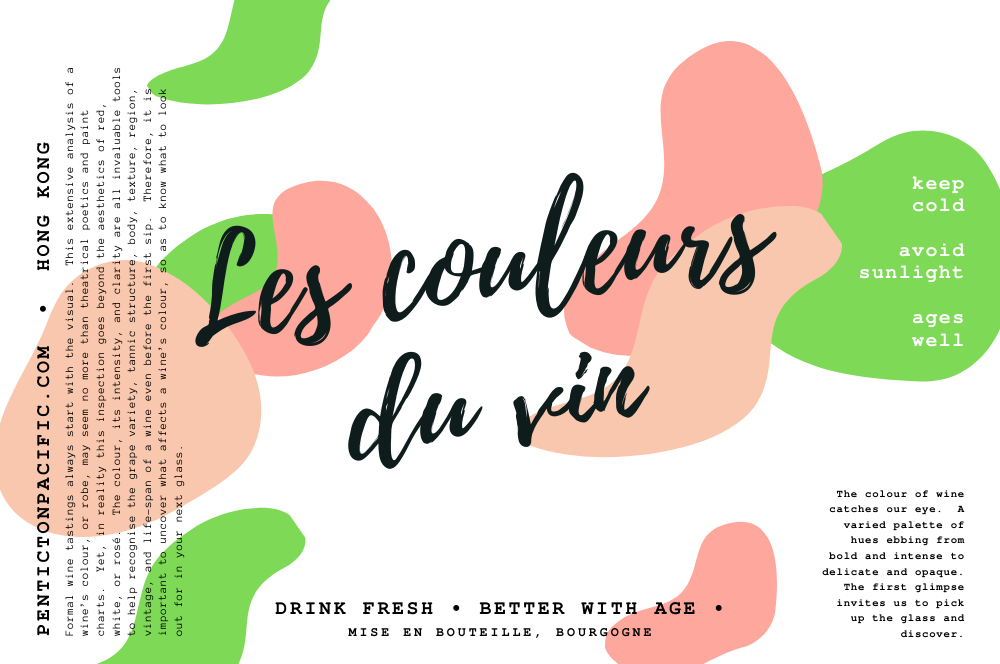Learn the Secrets behind the Colours of Burgundy Wine
The colour of wine catches our eye. A varied palette of hues ebbing from bold and intense to delicate and opaque. The first glimpse invites us to pick up the glass and discover.
Formal wine tastings always start with the visual. This extensive analysis of a wine’s colour, or robe, may seem no more than theatrical poetics and paint charts. Yet, in reality this inspection goes beyond the aesthetics of red, white, or rosé. The colour, its intensity, and clarity are all invaluable tools to help recognise the grape variety, tannic structure, body, texture, region, vintage, and life-span of a wine even before the first sip. Therefore, it is important to uncover what affects a wine’s colour, so as to know what to look out for in your next glass.
There are four main factors which can affect the colour of a wine:

Number #1 Grape Varietal.
It is the general rule that the phenolic compounds (including colour pigments) of a grape lie in the skin. It is for this reason that it is possible to make white wine from a red grape, since the flesh and juice are clear. Both red and white varietals have phenolic colour pigments, however it is the reds which dominate, diffusing substantial colour to a wine. Each grape varietal has a unique colour profile. As a result wines can range from lime-zest yellow to honey gold, fuchsia pink to brick-red garnet. It is important to note that a single grape varietal can have a completely different colour profile and structure depending on where in the world it is grown. A Pinot Noir from Burgundy will look (and taste) very different from a Pinot Noir from South Africa. The sun, soil, and expertise that goes into the term terroir all affect the development of a grape and therefore its colour.
In Burgundy, the lion share of white varietals is Chardonnay. On its own Chardonnay is a neutral variety, achieving much of its colour and flavour from its vinification. For the Reds, Pinot Noir dominates the region, with some Gamay in the south. Together they both create some of the palest reds with bright hues of raspberry and magenta when young.
*Secret No.1* Teinturier varietals. Although fairly rare and unknown, Teinturier varietals such as Alicante Bouschet and Petit Bouschet are a collection of grapes which hold bright colour pigment within the flesh and juice. Occasionally used to add depth of colour to blends, this is one colourful grape to look out for.

Number #2 Vinification
So, you have chosen your grape varietal and geographic location. However, the method of vinification can completely change the colour of a wine. As previously mentioned, white wine can be made from a red grape if the grapes are pressed directly and no skin contact is allowed, producing a very pale white wine. If you are looking for colour, maceration is key. The longer the juice macerates with the skins the deeper the colour will become. With red varietals maceration can be a sliding scale, producing anything from a 2hr macerated peach-coloured rosé to a 100 day macerated blackcurrant-coloured red.
*Secret No.2* Increasingly today, winemakers are experimenting with the maceration of white varietals, extracting their fragrance and fragile colour pigments to produce aromatic, amber-coloured orange wines.

Number #3 Oak and Oxidation.
The decision to age wine in oak or not, is similar to deciding how to season a recipe. Traditionally, certain regions, AOC’s, and grape varietals either lean towards using oak maturation or remaining au naturel. For example, winemakers of Chablis in the north of Burgundy, rarely choose oak maturation. Instead they rely on their zingy minerality to dominate their lime-yellow wines, whereas further south they often use oak to add a creamy richness to more butterscotch-coloured whites. Today more and more winemakers, particularly those who produce Natural wine, are taking a step back from the established rules. Adopting different ageing techniques, winemakers are known to experiment with concrete or stainless steel vats, and even terracotta amphorae. However, many still use oak barrels to both vinify and age their wines. The presence of oak can affect a wine’s colour, giving a tawny depth to reds and an earthy yellow to whites.
This all depends of a myriad of factors:
Q: Is the oak new or has it already aged several wines before?A: New oak will emit much more of its essence into a wine, than a barrel which has already aged several wines before it.
Q: Is it American or European?
A: Around the world varieties of oak differ and so will its impression on a wine.
Q: To what degree is the oak barrel smoked and seasoned?
A: A cooper (barrel-maker) can season the inside of a barrel with fire, giving aromas of caramel, cocoa, and tobacco, creating darker hues within the wine.
Q: Is it oak at all?
A: Although oak is the most common, other woods such as chestnut, pine, and acacia can be used to make barrels and will likewise have different influences on the wine.
*Secret No.3* Another reason why oak ageing affects the colour of wine is that the wood itself is porous. This allows for an exchange of oxygen between the wine and the air. Wine oxidation chemically deepens the colour. A winemaker must decide if they want oxidation to occur and to what degree. In some wines such as Vin Jaune in Jura winemakers seek this golden oxidative nutty quality.

Number #4 Evolution of colour
After a wine is bottled it continues to evolve. Depending on its quality and how it is stored, every wine has a shelf-life. Colour can be a useful indicator of where a wine is in its life-cycle. Overtime the pigment tends to dull. White wines darken with hints of amber and brown, while reds lighten to brick orange.
*Secret No.4* Tilt the glass over a lit white surface and observe the top ring where the wine touches the glass and is most translucent. There you will be able to see the tints of pigment.
New Colour. New Philosophy.

Cousins Régis & Sylvain have combined their expertise and the issue of climate change to support a conscientious cultivation of wine. They are sourcing artisanal secrets from around France, including in Burgundy. A new generation of independent winemakers are harnessing unique terroirs to create expressive and colourful wines.
Discover their Crément de Bourgogne Blanc de Blancs Extra Brut 2016, a sparkling alternative to Burgundy’s 100% Chardonnay classics. Located close to Péronne, this energetic fizz is fresh yet embodies the sun-kissed terroir of southern Burgundy. The pale golden colour of mirabelle, this wine is simply elegant with a slice of 24 month comté.
Or, if you are looking for tinted effervescence, why not try their Crément de Bourgogne Rosé Extra Brut 2017. Staying in the same region close to Péronne, this rosé counterpart is 100% Pinot Noir. A short maceration of 2hrs diffuses hues of coral pink with a mist of saffron, pairing perfectly with tuna sashimi.
Try their Bourgogne Pinot Noir 2017. This still red wine exhibits delicately opaque ruby tints.
Light-bodied yet full of sunshine from its south-facing plot north-west of Mâcon, its black fruits and spices compliment the fragrance of a rosemary-roasted lamb shoulder.
Colour is the visual expression of a wine’s story. From grape to bottle, every decision made can affect the colour. Take these tools to uncover the secrets behind the colours of Burgundy wine.



